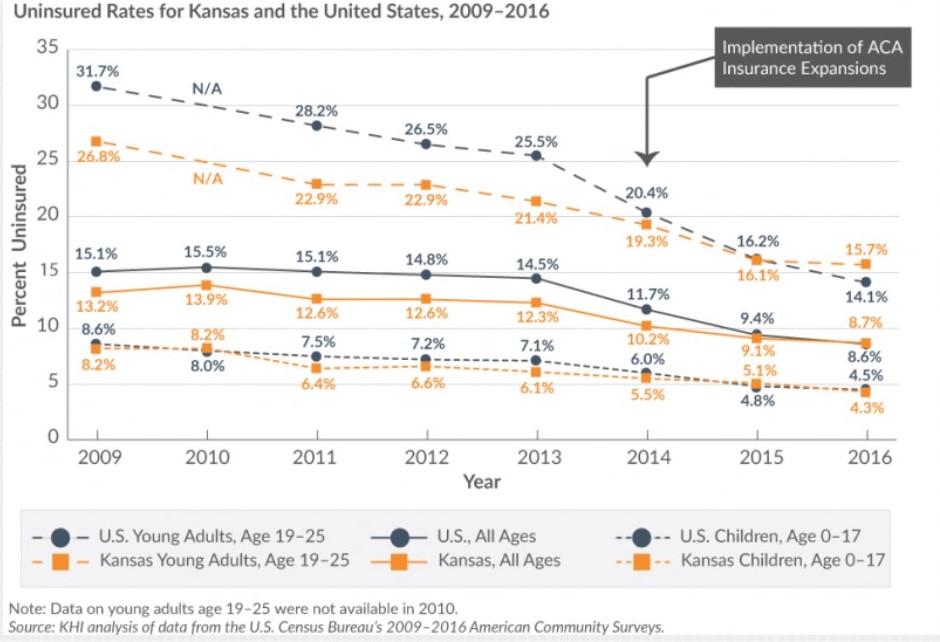Topeka, Kan.—The U.S. Census Bureau today released its latest estimates on health insurance coverage. The uninsured rate in the U.S. continued its decline that began in 2014 with implementation of the major insurance expansions of the Affordable Care Act (ACA). In 2016, the U.S. uninsured rate was 8.6 percent (27.3 million uninsured), down significantly from 9.4 percent (29.8 million uninsured) in 2015. The Kansas uninsured rate was 8.7 percent (249,000 uninsured) in 2016, not significantly different from the rate of 9.1 percent (261,000 uninsured) in 2015.
Data from the recent years of the American Community Survey (ACS) 1-year Estimates also show that the longstanding edge that Kansas enjoyed prior to 2014—by having an uninsured rate below that of the country as a whole—has disappeared, and for some groups, has even reversed.
-
- For the first time, the uninsured rate in Kansas was statistically the same as the U.S. overall (8.7 percent in Kansas compared to 8.6 percent for the U.S.).
- Kansas children age 0-17 are no longer less likely to be uninsured than their counterparts nationally (4.3 percent in Kansas compared to 4.5 percent for the U.S.). From 2011 to 2014, children in Kansas were less likely to be uninsured than those in the country as a whole, but children in other states have made larger gains in insurance coverage since that time.
- Young adults in Kansas age 19-25 are now actually more likely to be without insurance than other people their age around the country (15.7 percent in Kansas compared to 14.1 percent for the U.S.). Prior to 2014, young adults in Kansas were less likely to be uninsured compared to their peers nationally.
- White, non-Hispanic Kansans were previously less likely to be uninsured than those in other states, but are now more likely to be uninsured (6.4 percent in Kansas compared to 5.7 percent for the U.S.).
- Kansans who are Hispanic or Black/African American were previously about as likely as those across the country to be uninsured, but now are more likely to be uninsured (Hispanic = 20.5 percent in Kansas compared to 18.0 percent for the U.S.; Black/African American = 14.3 percent in Kansas compared to 9.7 percent for the U.S.).
- Kansans living below the poverty line are one-third more likely to be uninsured than poor persons living in other states (22.0 percent in Kansas compared to 16.0 percent for the U.S.). The gap in insurance coverage between poor persons in Kansas and the rest of the country has widened since 2014 when many states expanded their Medicaid program to cover more low-income adults.
Even without Medicaid expansion, the uninsured rate in Kansas has decreased from 12.3 percent in 2013 to an all-time low of 8.7 percent in 2016. But the trend in Kansas and other states that have not expanded Medicaid is slowing while other states are experiencing continued improvement—a trend worth monitoring as federal and state health policy continues to evolve.
“Kansas’ slide compared to other states is largely explained by the lack of Medicaid expansion but may also reflect a generally negative approach to many elements of the ACA,” said Robert F. St. Peter, M.D., president and CEO of the Kansas Health Institute. “We know the amount of outreach and enrollment activity to let people know they may be eligible for substantial subsidies to buy private insurance on the marketplace, or, that even without expansion, they or their children might already be eligible for Medicaid or CHIP, undoubtedly affects the number of persons insured, especially among working families that are low- or middle-income.”
Another possibility that should be examined is whether the gain in private insurance coverage through employers in Kansas was similar to other states. It will take additional analysis to determine whether or not this contributed to the slower reduction in the uninsured rate in Kansas.
Additional charts and information on the data released today can be found on the KHI website.
The U.S. Census Bureau will release additional data with state-level detail on October 19, 2017. KHI will perform additional analysis of these data when available. Please check our website frequently for additional information.
NOTE: This analysis uses data from the 2009-2016 American Community Surveys (ACS) 1-year Estimates released today. Earlier this week, the U.S. Census Bureau also released data from the 2016 Current Population Survey (CPS). Estimates of insurance coverage may differ slightly between the ACS and CPS. The ACS estimates are better for analyzing state-level data and were used in this analysis.
